One of the first and most exciting signs of spring in Japan is when flowers start blooming. The cherry blossom or Sakura is the best-known flower during the spring season. However, there is a flower that blooms before the Sakura tree, and it has played an important role in Japanese culture and tradition for many centuries: we are talking about the plum blossom.
The flowering season of the plum blossom (sometimes called Japanese apricot) starts in early February, during the cold winter, and lasts until the end of March, when the warm weather begins. It is said that plum blossoms are the original flower with which the tradition of the Hanami (flower viewing parties) began in Japan.
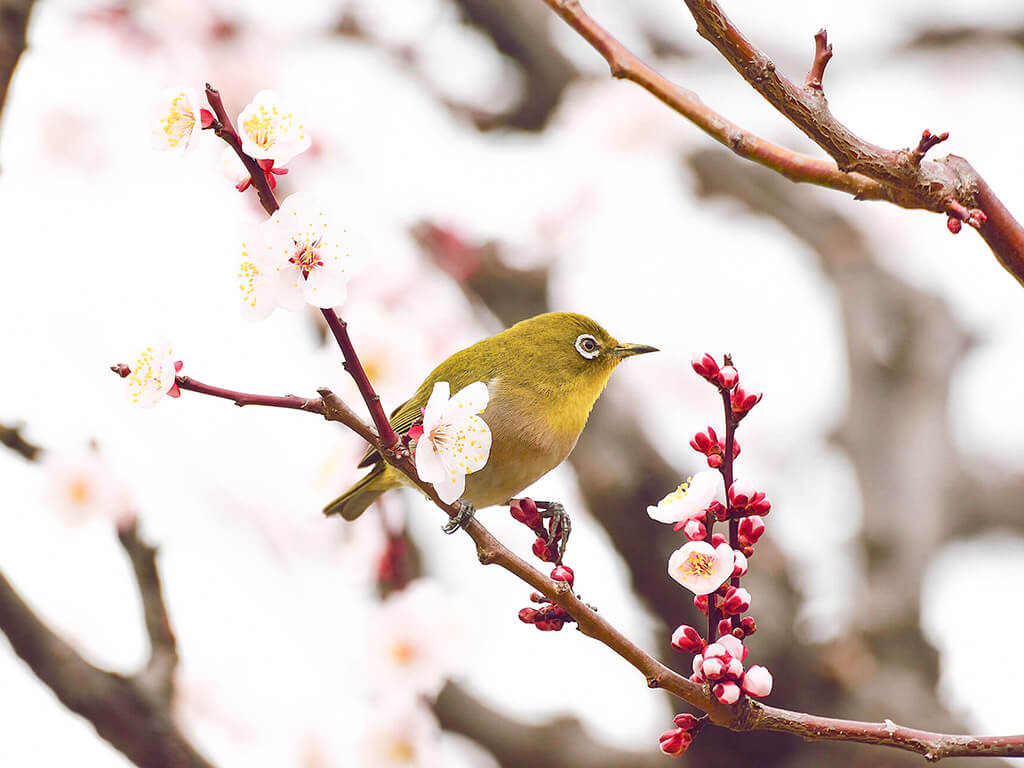
The plum trees were initially introduced into Japan from China and were considered ornamental trees for the gardens of the nobility and public spaces. Associated with good fortune, it is believed that the plum fruit and trees themselves avoid evil, so they can often be found around sanctuaries, temples, and other spiritual areas.
Plum blossoms are a very common motif in kimono designs, Obi (kimono sash), and other Japanese fabrics. They are often associated with the concept of maturity and are also represented in many works of art along with the Japanese white-eye and mountain white-eye, two popular local species of birds.
Japanese plums are not only famous for their flowers but also for their fruit, the plum called Ume in Japanese. These plums have an acidic flavor and are often prepared as a pickle called Umeboshi, which is used in different dishes like Onigiri (rice balls), soups, snacks, candies, and in a very popular liquor called Umeshu (plum liqueur).
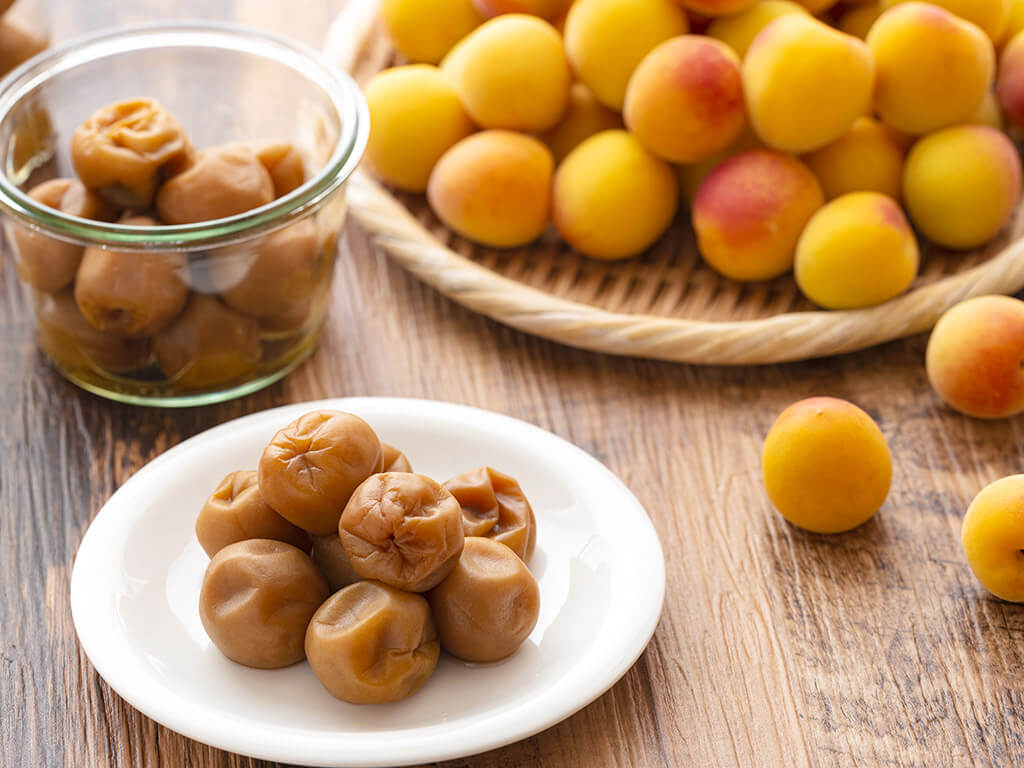
The colors of the plum flowers differ from those of sakura flowers. They come in a broader range of shades of roses and reds to white and vivid fuchsia. The petals typically have a round tip with five or more petals. Another distinguishing characteristic is that plum flowers grow directly from the branches, unlike sakura flowers, which grow from the stems.
Here are the top spots in Nagoya and the greater Aichi area to see plum blossoms.
Article Contents
Nagoya Agricultural Center ‘dela Farm’
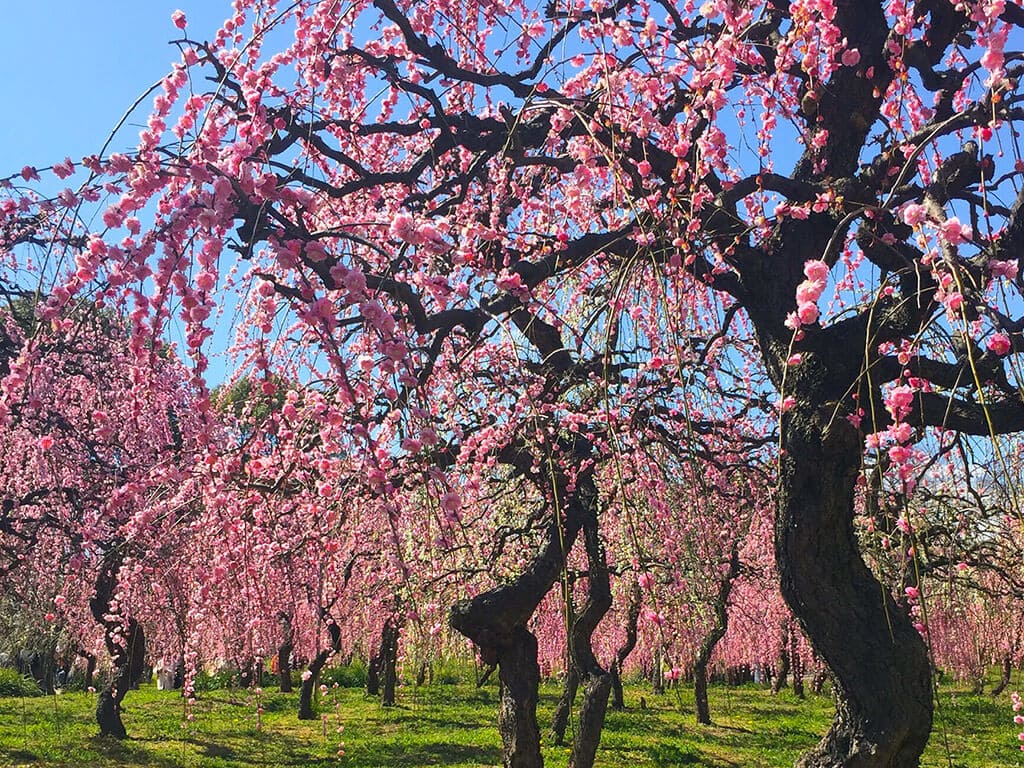
Enjoy the beautiful plum blossoms during the Weeping Plum Blossoms Festival (Shidare Ume Matsuri) at the Nagoya Agricultural Center ‘dela Farm’. In addition to having one of the largest plum fields in Japan, the Nagoya Agricultural Center also has a large variety of other flowers. Also, you may have the chance to get close to some of the different farm animals that live there.
Note: The Nagoya Agricultural Center ‘dela Farm’ has been undergoing major renovations since March 2023. Although some areas have been reopened in October 2023, please note that not all areas might be available during the plum blossom season in 2024.
Nagoya Agricultural Center ‘dela Farm’ (名古屋市農業センターdelaふぁーむ)
Best time: From the end of February to mid-March.
* The duration of the festival may vary depending on the condition of the flowers.
Entry Fee: Free admission
Opening Hours: 9:00 – 16:30. Closed on Mondays
Address: Kuroishi-2872-3 Tenpakucho Oaza Hirabari, Tempaku Ward, Nagoya, Aichi 468-0021
Access: Take the Tsurumai subway line and get off at Hirabari station. Take exit 1. From there it is a 20-minute walk.
Website (Japanese only) | Google Maps
Arako Park
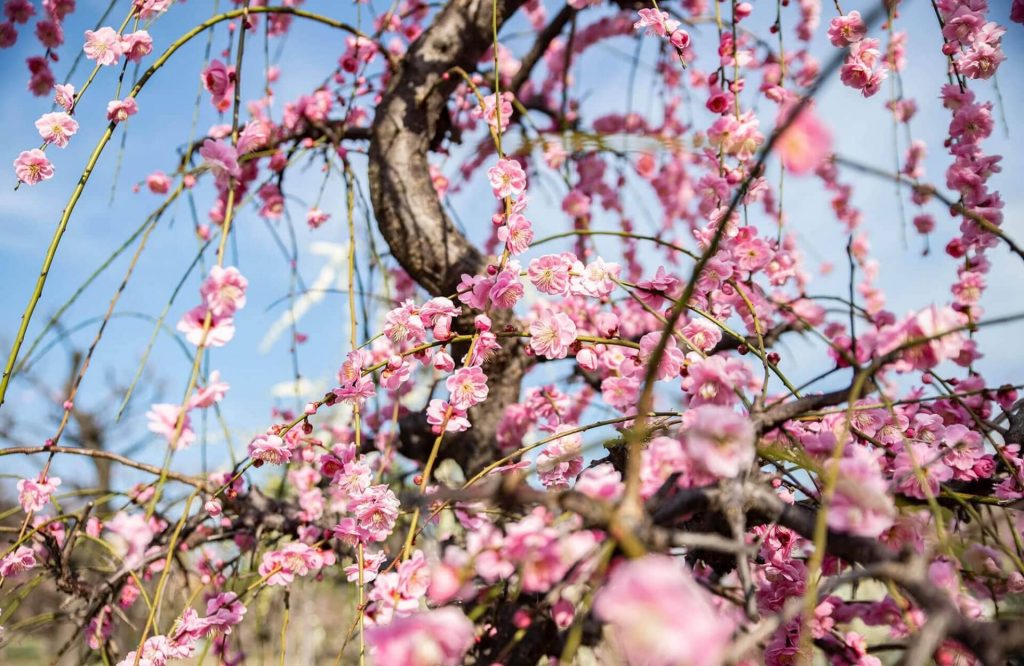
Arako Park is located behind the Arako Kannon Temple in Nakagawa ward, Nagoya. The park has different varieties of plum trees with white, red, and pink flowers. You can also see the weeping plum tree variety, one of the most beautiful varieties of plum trees. Different events such as Taiko performances, dances, and concerts are held during the annual Ume Festival.
Arako Park (荒子公園)
Best time: From early March to mid-March
Entry Fee: Free admission
Opening Hours: Open 24 hours
Address: 2 Arako, Nakagawa Ward, Nagoya, Aichi 454-0869
Access: Take the Aonami train line and get off at Arako station. From there it’s a 6 minutes walk.
Google Maps
Togokusan Fruit Park
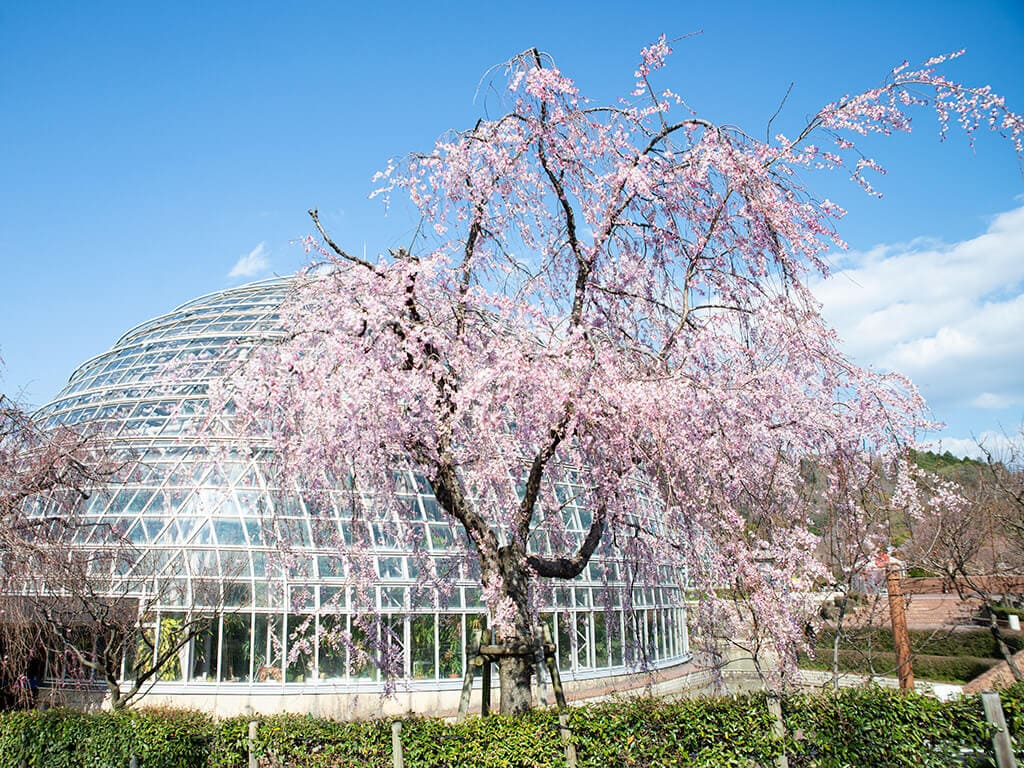
Togokusan Fruit Park is dedicated to agricultural education, specifically focusing on fruits. It features 15 separate orchards showcasing a variety of local and global fruits, providing visitors with the chance to see around 100 tropical and subtropical fruit species. In addition, the park also has a catch-and-release fishing area, a Japanese garden, and fields full of flowers and seasonal plants. Visitors can also enjoy restaurants that serve dishes made with the produce harvested from the park itself, and shops selling said produce as well. The park boasts 200 plum trees, representing 21 different varieties, which bloom from January to March.
Togokusan Fruit Park (東谷山フルーツパーク)
Best time: From early February to early March
Entry Fee: Free admission. Separate Admission to the World Tropical Fruit Greenhouse required
Opening Hours: 9:00 – 16:30. Closed on Mondays
Address: Togoku-2110 Kamishidami, Moriyama Ward, Nagoya, Aichi 463-0001
Access: Take the JR Chuo train line, get off at Kozoji Temple Station, and take the south exit. From there it’s a 25 minutes walk.
Website | Google Maps
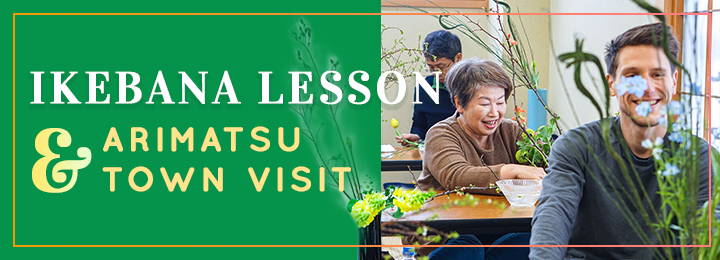
Higashiyama Zoo and Botanical Gardens
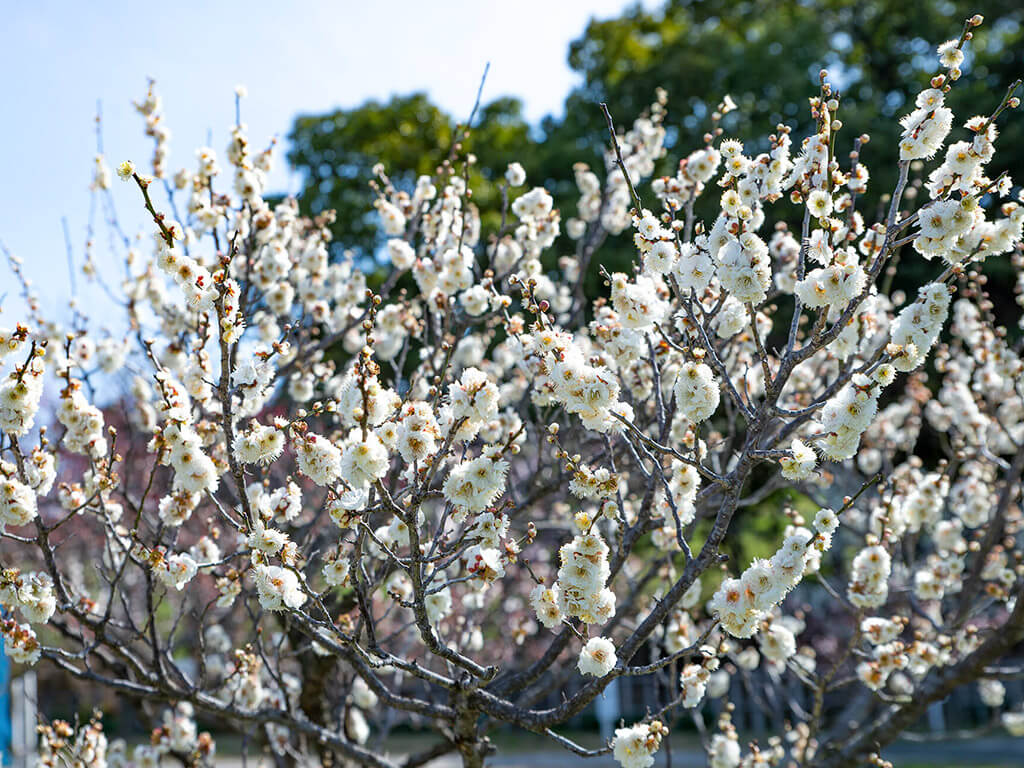
Founded in 1937, the Higashiyama Zoo and Botanical Gardens is a wonderful place to spend the day as well as see plum blossoms. The Higashiyama Zoo is one of the best in Japan, while the adjacent Botanical Gardens boasts an impressive collection of over 7,000 types of plants. Within the Botanical Gardens two plum groves feature more than 20 different varieties of plum trees, totaling over 200 individual trees.
The Botanical Gardens also house Japan’s oldest glasshouse, registered as an Important Cultural Property. Additionally, an original Gassho-zukuri -a wooden house built with a steep thatched roof that looks like two hands clasped together- has been relocated from the World Heritage-listed Shirakawa-go Village in neighboring Gifu Prefecture.
Higashiyama Zoo and Botanical Gardens (東山動植物園)
Best time: From mid-February to mid-March
Entry Fee: 500 yen per person
Opening Hours: 9:00 – 16:30. Closed on Mondays
Address: 3-70 Motomachi, Higashiyama, Chikusa Ward, Nagoya, Aichi 464-0804
Access: Take the Higashiyama subway line and get off at Higashiyamakoen station. Take exit 3. From there it is a 7-minute walk.
Website | Google Maps
Nagoya Castle
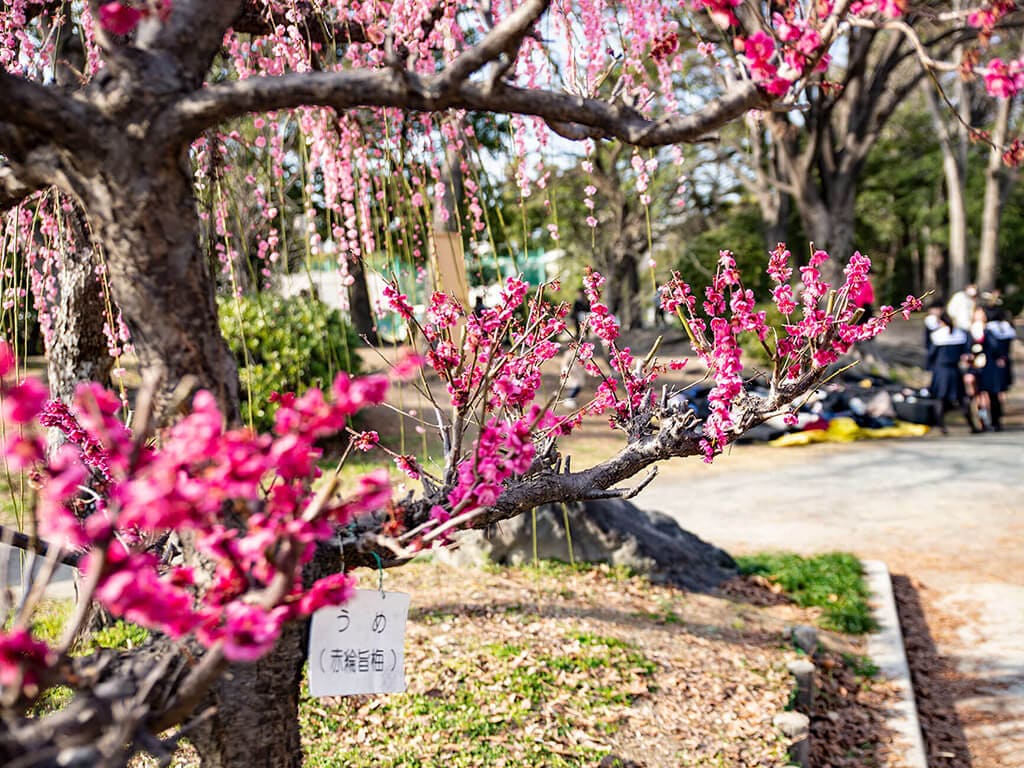
The grounds of Nagoya Castle are home to 10 kinds of plum trees and around 100 individual trees. The nearby Meijo Park also has around 50 plum trees of 4 different varieties.
While the keep of Nagoya Castle is currently closed for reconstruction in its original style, the newly completed Honmaru Palace on the grounds is open to visitors. Originally built in 1615, Nagoya Castle was destroyed during World War II. Through meticulous efforts and referencing incredibly detailed historical records, the Honmaru Palace has been painstakingly rebuilt to its original glory.
Nagoya Castle (名古屋城)
Best time: From mid-February to mid-March
Entry Fee: 500 yen per person
Opening Hours: 9:00 – 16:30
Address: 1-1 Honmaru, Naka Ward, Nagoya, Aichi 460-0031
Access: Take the Meijo subway line and get off at Shiyakusho station. Take exit 7. From there it is a 5-minute walk.
Website | Google Maps
Odaka Ryokuchi Park
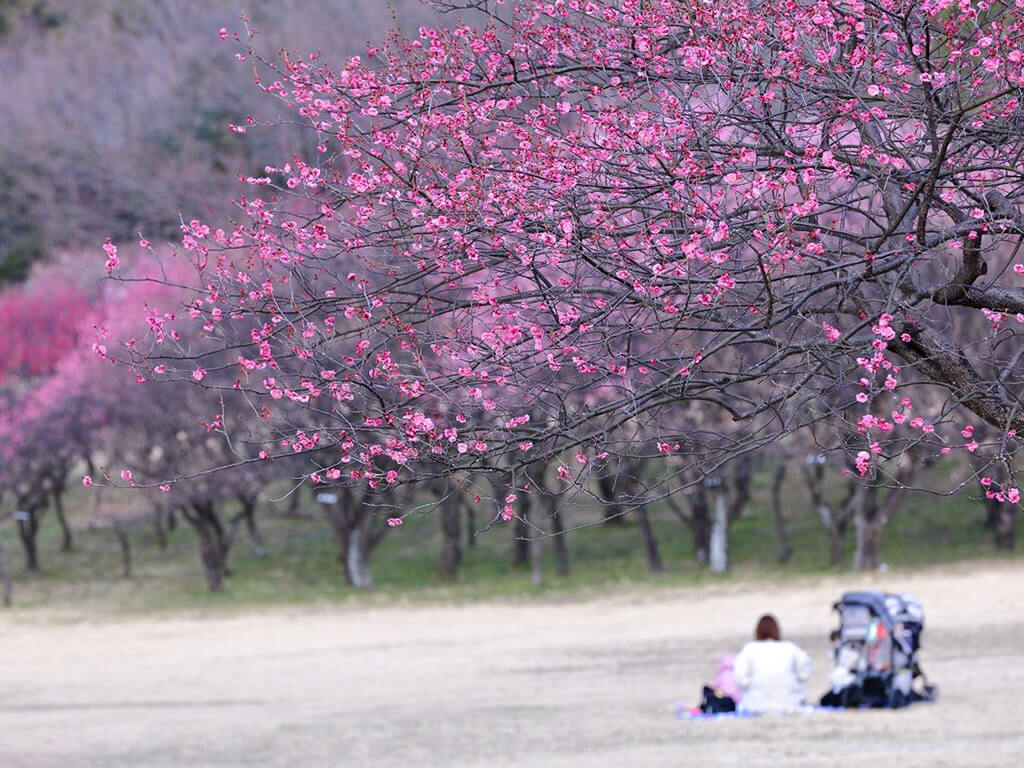
Located in the southern part of Nagoya, Odaka Ryokuchi Park has 120 hectares of green space and loads of family-friendly attractions. The park offers 16 kinds of white and red plum trees and approximately 400 individual trees. Most trees can be found inside the park’s Japanese garden.
Among the park’s family-friendly attractions are paddle boat rentals, go-karts, an 18-hole miniature golf course, and a Dinosaur Adventure!
Odaka Ryokuchi Park (大高緑地)
Best time: From the end of February to mid-March
Entry Fee: Free admission
Opening Hours: Open 24 hours
Address: Takayama-1-1 Odakacho, Midori Ward, Nagoya, Aichi 459-8801
Access: Take the Meitetsu train to Sakyoyama station. From there is a short walk to park’s entrance.
Website (Japanese only) | Google Maps
Okazaki Minami Park (Okazaki)
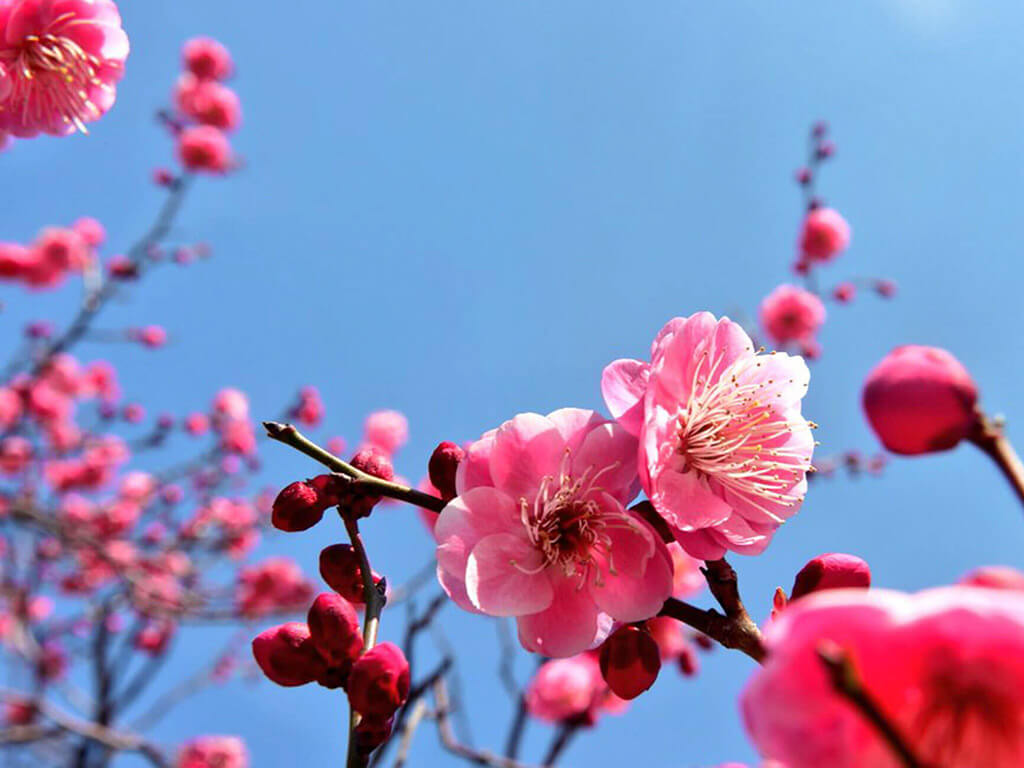
The Okazaki Minami Park houses 19 varieties and almost 200 individual plum trees. Some plum trees in this park begin to bloom in January while other varieties are in bloom until the end of March. For this reason, you can enjoy the beauty of plum blossoms for almost three months. On weekends, there are street food stalls, samurai shows, and other street artist performances.
Okazaki Minami Park (南公園)
Best time: From mid-February to early March
Entry Fee: Free admission
Opening Hours: 9:00 – 17:00
Address: Kayabayashi-1-1 Wakamatsucho, Okazaki, Aichi 444-0826
Access: Take the Meitetsu train to Higashi Okazaki station. There, take a Meitetsu bus to Miai through Shokokaigisho-mae and Midorigaoka (other lines are also available). Get off at Minamikoen-kita and walk for about 5 minutes. Or take the JR Tokaido train to Okazaki station. There, take the Meitetsu bus to Fukuoka-cho through Minami Wakamatsu (other lines are also available). Get off at Wakamatsu-cho and walk for about 8 minutes.
Website | Google Maps
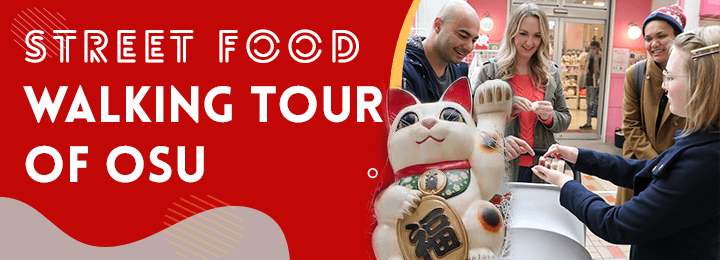
Mukaiyama Ryokuchi Greens Park (Toyohashi)
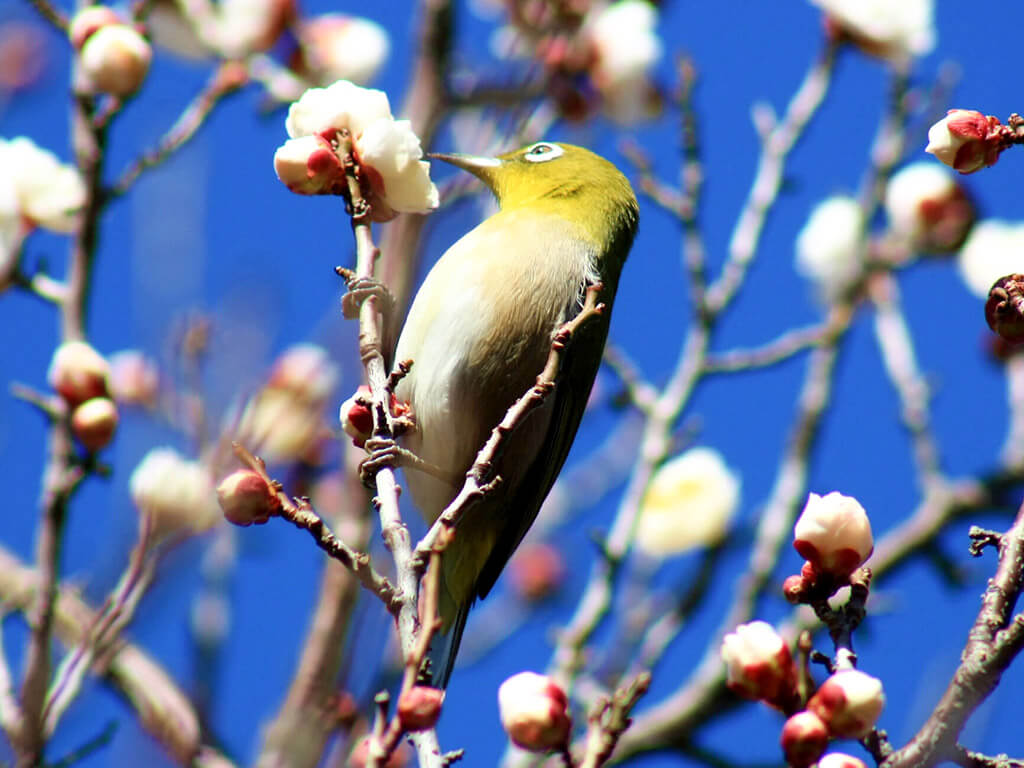
The Mukaiyama Ryokuchi Park spans 13,000m2 and features 400 plum trees representing 28 different species that bloom at different times. Additionally, the park also has 1,000 cherry trees which makes it a great place to visit during spring.
Mukaiyama Ryokuchi Greens Park (向山緑地)
Best time: End of January to early March
Entry Fee: Free admission
Opening Hours: Open 24 Hours
Address: Mukaiyamaoikecho, Toyohashi, Aichi 440-0862
Access: From Toyohashi station, take the Toyotetsu bus (Tenpaku Danchi line) and get off at the Dai-machi stop. From there it is a 4 minutes walk.
Google Maps
Oagata Shrine (Inuyama)
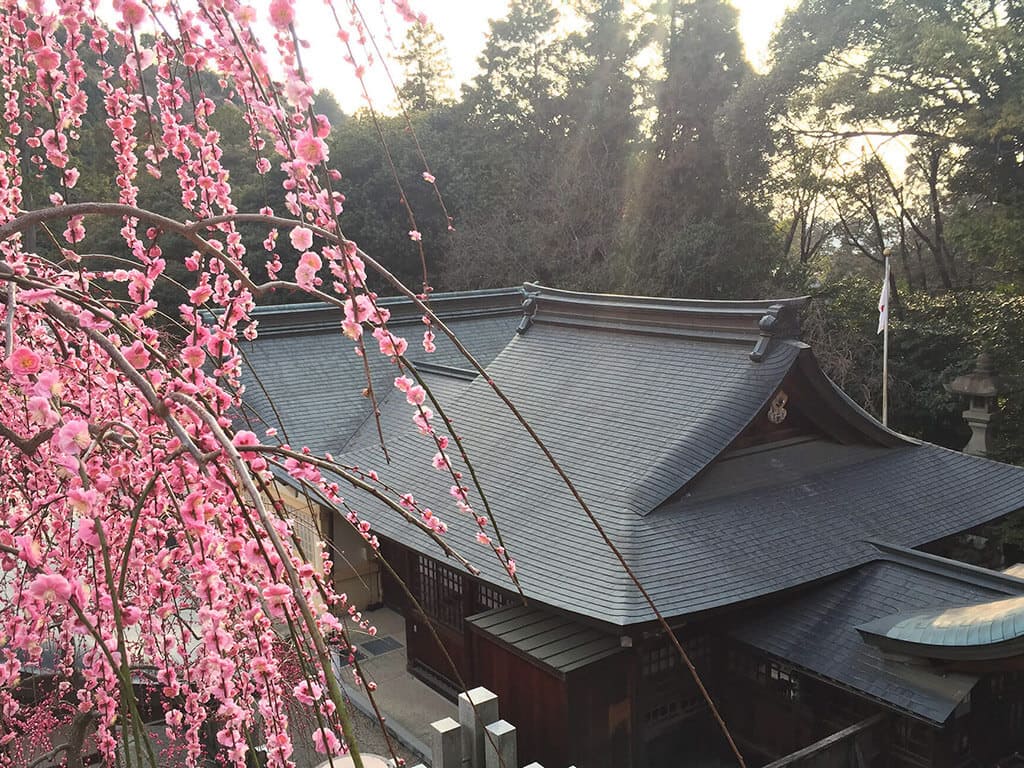
There is a small hill at the back of the Oagata Shrine filled with many varieties of plum trees. The plum trees’ flowers range in color from white to pink and are spread across the hill. A lot of visitors come here every year in mid-March to see the beautiful plum flowers in full bloom.
In addition to admiring the splendid plum flowers in Inuyama, there are many other things to enjoy in this city. Visit its popular castle town, Showa Alley, take a scenic river ride with local food and sake, or travel back in time by visiting the Meiji Mura open-air museum.
Oagata Shrine (大縣神社)
Best time: From mid-February to mid-March
Entry Fee: Free admission
Opening Hours: Open 24 hours
Address: 3 Miyayama, Inuyama, Aichi 484-0834
Access: Take the Meitetsu Komaki line and get off at Gakuden station. From there it is a 20-minute walk.
Website (Japanese only) | Google Maps
Souri Green & Flower Fureai Park (Chita)
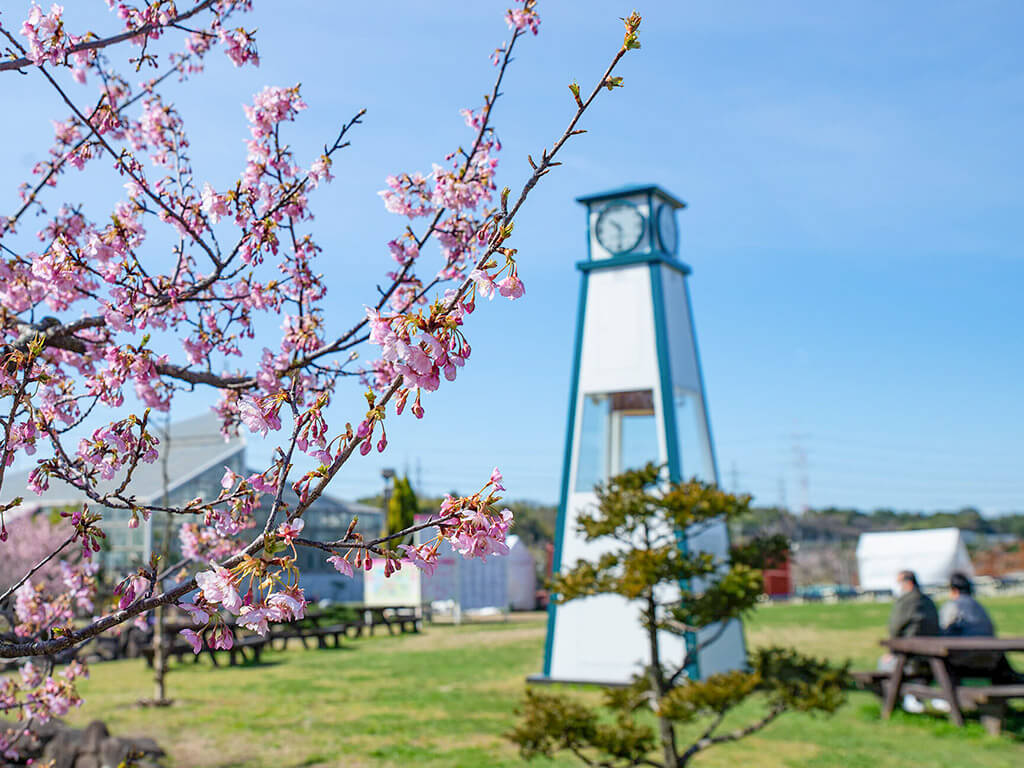
This is a park that houses more than 6,000 plum trees of 25 different varieties planted on the edge of Lake Souri. Every year during the Plum Festival (Souri Ike Ume Matsuri) more than 150,000 visitors come to enjoy the plum blossoms. During the festival, there are different events held, such as Taiko performances and comedy shows.
Souri Green & Flower Fureai Park (佐布里 緑と花のふれあい公園)
Best time: Mid-February to mid-April
Entry Fee: Free admission
Opening Hours: 9:00 – 17:00. Closed on Mondays
Address: 3-101 Souridai, Chita, Aichi 478-0018
Access: Take the Meitetsu Tokoname Line and get off at Asakura station. Take the Chita Bus bound for Souri and get off at Ume no Yakata-guchi. From there it is a 5-minute walk.
Website (Japanese only) | Google Maps
This post was last updated in January 2024.
Although we strive to provide you with the most accurate and up-to-date information possible, please note that changes may occur nonetheless. We recommend you confirm any relevant information such as event cancelations or changes, opening hours, or possible restrictions using a direct source. Please keep in mind that these sources might be in Japanese only.
Did you enjoy this article?
Make sure to also check out our other posts about Nagoya and trust us if we say Nagoya is not boring!
Be sure to follow us on Facebook for regular updates on Nagoya, and see our Instagram for pictures and stories about the city!
Tag us 📲
If you have visited any of these plum blossom spots in/around Nagoya or found a few other spots please share your experience and tag us on social media with #nagoyaisnotboring


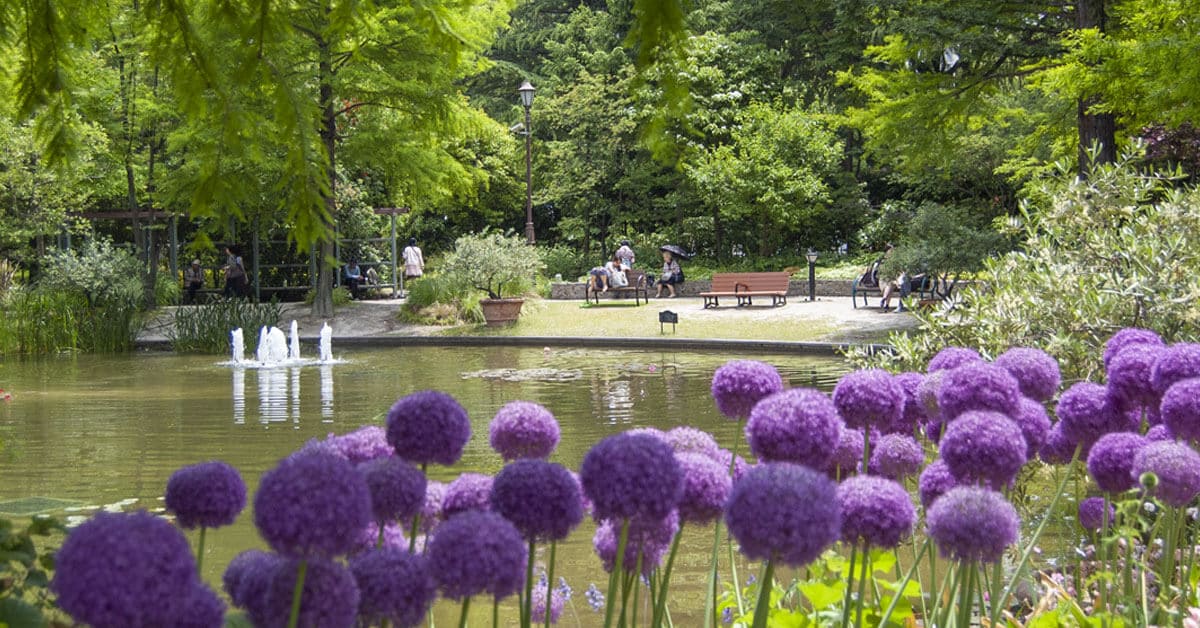
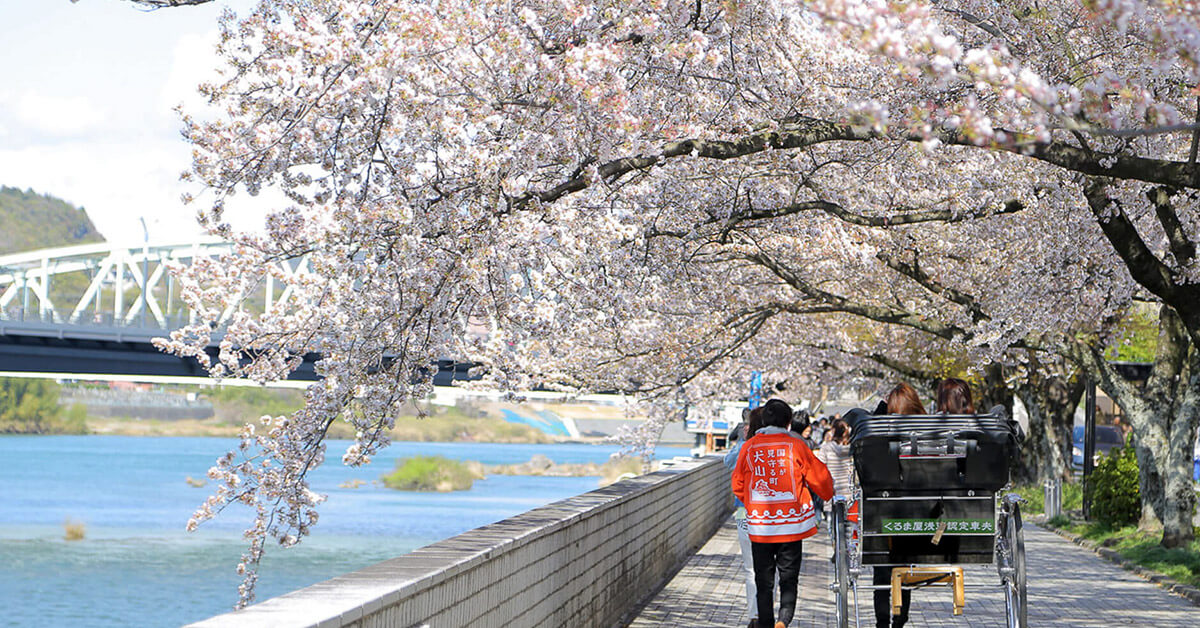


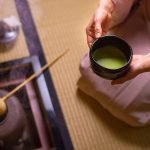
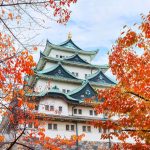
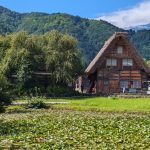

I’ve been to all of these places except for Mukaiyama. They’re all pretty amazing, especially Ogata and Togokusan. There is a park in Higashiura, near the Aeon that has a beautiful display of Shidare Ume. They are in bloom even now. Check it out.
Hi,
Thanks for the tip! I haven’t been to the park in Higashiura yet, but it sounds wonderful with the Shidare Ume in bloom. I’ll definitely check it out soon. Appreciate you sharing your experiences!